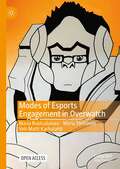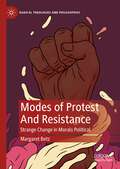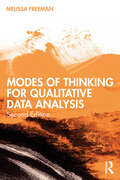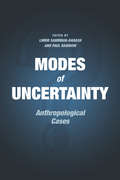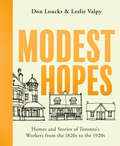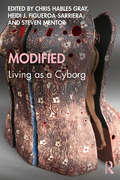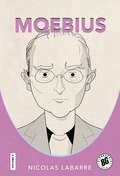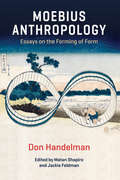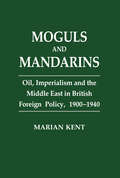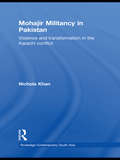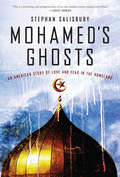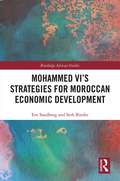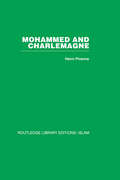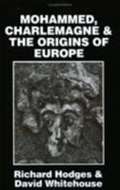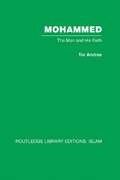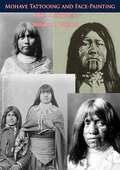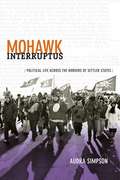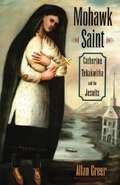- Table View
- List View
Modes of Esports Engagement in Overwatch
by Veli-Matti Karhulahti Maria Ruotsalainen Maria TörhönenThis Open Access book provides a comprehensive review of the rapidly developing esport phenomenon by examining one of its contemporary flagship titles, Overwatch (Blizzard Entertainment 2016), through three central themes and from a rich variety of research methods and perspectives. As a game with more than 40 million individual players, an annual international World Cup, and a franchised professional league with teams from Canada, China, Europe, South Korea, and the US, Overwatch provides a multifaceted perspective to the cultural, social, and economic topics associated with the development of esports, which has begun to attract attention from both commercial and academic audiences.The book starts with an introduction chapter to Overwatch and esports engagement in general, co-authored by the editors. This is followed by 15 unique chapters from scholars within the field of game cultures and esports, representing ten different nationalities. The contributions construct thematic sections that divide the book into three parts: Players, Diverse Audiences? and Fan & Fiction Work. As such, the parts provide a wide-ranging overview of esport engagement, thus disclosing the phenomenon’s cross-cultural, transmedial, and interconnected relations that have not been probed earlier in a single anthology.
Modes of Protest And Resistance: Strange Change in Morals Political (Radical Theologies and Philosophies)
by Margaret BetzThis book presents a philosophical analysis of the different forms of political resistance and protest. It explores the normative space of resistance that is beyond self-defense and civil disobedience, and proposes the concept of “resistance violence” as a separate and special normative category. Instances that fall under this category can be, accordingly justified, even if they prove to be practically ineffective, by appealing to their role in preserving or upholding the dignity of the resistors or those who they aim to protect. Margaret Betz draws from important and interesting historical examples to establish the concept, and proposes to apply it to better understand contemporary struggles against injustice.
Modes of Thinking for Qualitative Data Analysis
by Melissa FreemanModes of Thinking for Qualitative Data Analysis offers a creative and comparative account of the conceptual and philosophical underpinnings of six prominent analytical movements used by interdisciplinary qualitative researchers: Categorical thinking, narrative thinking, dialectical thinking, poetic thinking, diffractive thinking, and decolonial thinking.Each “mode of thinking” engages in a particular process for analytical sense-making. Every chapter describes core characteristics of the focal analytical movement along with examples to illustrate what that approach might look like in practice. By presenting these analytical movements in the space of a single text, the author not only highlights their unique contributions to qualitative analysis but also creates a structure from which to understand their strengths and challenges, as well as the kind of outcomes and realities each participates in shaping.This book is a thought-provoking resource for experienced and novice interdisciplinary qualitative researchers seeking to deepen their understanding of the variety of ways qualitative analysis is, and could be, theorized and practiced.
Modes of Uncertainty: Anthropological Cases
by Paul Rabinow Limor Samimian-Darah and Paul RabinowModes of Uncertainty offers groundbreaking ways of thinking about danger, risk, and uncertainty from an analytical and anthropological perspective. Our world, the contributors show, is increasingly populated by forms, practices, and events whose uncertainty cannot be reduced to risk—and thus it is vital to distinguish between the two. Drawing the lines between them, they argue that the study of uncertainty should not focus solely on the appearance of new risks and dangers—which no doubt abound—but also on how uncertainty itself should be defined, and what the implications might be for policy and government. Organizing contributions from various anthropological subfields—including economics, business, security, humanitarianism, health, and environment—Limor Samimian-Darash and Paul Rabinow offer new tools with which to consider uncertainty, its management, and the differing modes of subjectivity appropriate to it. Taking up policies and experiences as objects of research and analysis, the essays here seek a rigorous inquiry into a sound conceptualization of uncertainty in order to better confront contemporary problems. Ultimately, they open the way for a participatory anthropology that asks crucial questions about our contemporary state.
Modes of the Tragic in Spanish Cinema
by Luis M. GonzálezThis book focuses on expressions of the tragic in Spanish cinema. Its main premise is that elements from the classical and modern tragic tradition persist and permeate many of the cultural works created in Spain, especially the films on which the book centers this study. The inscrutability and indolence of the gods, the mutability of fortune, the recurrent narratives of fall and redemption, the unavoidable clash between ethical forces, the tension between free will and fate, the violent resolution of both internal and external conflicts, and the overwhelming feelings of guilt that haunt the tragic heroine/hero are consistent aspects that traverse Spanish cinema as a response to universal queries about human suffering and death.
Modest Hopes: Homes and Stories of Toronto's Workers from the 1820s to the 1920s
by Don Loucks Leslie ValpyCelebrating Toronto’s built heritage of row houses, semis, and cottages and the people who lived in them.Despite their value as urban property, Toronto’s workers’ cottages are often characterized as being small, cramped, poorly built, and in need of modernization or even demolition. But for the workers and their families who originally lived in them from the 1820s to the 1920s, these houses were far from modest. Many had been driven off their ancestral farms or had left the crowded conditions of tenements in their home cities abroad. Once in Toronto, many lived in unsanitary conditions in makeshift shantytowns or cramped shared houses in downtown neighbourhoods such as The Ward. To then move to a self-contained cottage or rowhouse was the result of an unimaginably strong hope for the future and a commitment to family life. Through the stories of eight families who lived in these “Modest Hopes,” authors Don Loucks and Leslie Valpy bring an important but forgotten part of the Toronto narrative to life. They illuminate the development of Toronto’s working-class neighbourhoods, such as Leslieville, Corktown, and others, and explain the designs and architectural antecedents of these undervalued heritage properties.
Modest_Witness@Second_Millennium. FemaleMan_Meets_OncoMouse: Feminism and Technoscience
by Donna J. Haraway Thyrza GoodeveOne of the founders of the posthumanities, Donna J. Haraway is professor in the History of Consciousness program at the University of California, Santa Cruz. Author of many books and widely read essays, including the now-classic essay "The Cyborg Manifesto," she received the J.D. Bernal Prize in 2000, a lifetime achievement award from the Society for Social Studies in Science. Thyrza Nicholas Goodeve is a professor of Art History at the School of Visual Arts.
Modi's India: Hindu Nationalism and the Rise of Ethnic Democracy
by Christophe JaffrelotA riveting account of how a popularly elected leader has steered the world's largest democracy toward authoritarianism and intoleranceOver the past two decades, thanks to Narendra Modi, Hindu nationalism has been coupled with a form of national-populism that has ensured its success at the polls, first in Gujarat and then in India at large. Modi managed to seduce a substantial number of citizens by promising them development and polarizing the electorate along ethno-religious lines. Both facets of this national-populism found expression in a highly personalized political style as Modi related directly to the voters through all kinds of channels of communication in order to saturate the public space.Drawing on original interviews conducted across India, Christophe Jaffrelot shows how Modi's government has moved India toward a new form of democracy, an ethnic democracy that equates the majoritarian community with the nation and relegates Muslims and Christians to second-class citizens who are harassed by vigilante groups. He discusses how the promotion of Hindu nationalism has resulted in attacks against secularists, intellectuals, universities, and NGOs. Jaffrelot explains how the political system of India has acquired authoritarian features for other reasons, too. Eager to govern not only in New Delhi, but also in the states, the government has centralized power at the expense of federalism and undermined institutions that were part of the checks and balances, including India's Supreme Court.Modi's India is a sobering account of how a once-vibrant democracy can go wrong when a government backed by popular consent suppresses dissent while growing increasingly intolerant of ethnic and religious minorities.
Modified: GMOs and the Threat to Our Food, Our Land, Our Future
by Caitlin ShetterlyA disquieting and meditative look at the issue that started the biggest food fight of our time--GMOs. From a journalist and mother who learned that genetically modified corn was the culprit behind what was making her and her child sick, a must-read book for anyone trying to parse the incendiary discussion about genetically modified foods.GMO products are among the most consumed and the least understood substances in the United States today. They appear not only in the food we eat, but in everything from the interior coating of paper coffee cups and medicines to diapers and toothpaste. We are often completely unaware of their presence.Caitlin Shetterly discovered the importance of GMOs the hard way. Shortly after she learned that her son had an alarming sensitivity to GMO corn, she was told that she had the same condition, and her family's daily existence changed forever. An expansion of Shetterly's viral Elle article "The Bad Seed," Modified delves deep into the heart of the matter--from the cornfields of Nebraska to the beekeeping conventions in Brussels--to shine a light on the people, the science, and the corporations behind the food we serve ourselves and our families every day. Deeper than an exposé, and written by a mother and journalist whose journey had no agenda other than to understand the nuance and confusion behind GMOs, Modified is a rare breed of book that will at once make you weep at the majestic beauty of our Great Plains and force you to harvest deep seeds of doubt about the invisible monsters currently infiltrating our food and our land and threatening our future.From the Hardcover edition.
Modified: GMOs and the Threat to Our Food, Our Land, Our Future
by Caitlin ShetterlyA disquieting and meditative look at the issue that started the biggest food fight of our time--GMOs. From a journalist and mother who learned that genetically modified corn was the culprit behind what was making her and her child sick, a must-read book for anyone trying to parse the incendiary discussion about genetically modified foods.*One of Publishers Weekly's Best Books 2016*"More so than definitive answers, the questions that Shetterly advances are a persuasive reminder of how important the continued fight for true transparency in the food industry is." --GoopGMO products are among the most consumed and the least understood substances in the United States today. They appear not only in the food we eat, but in everything from the interior coating of paper coffee cups and medicines to diapers and toothpaste. We are often completely unaware of their presence.Caitlin Shetterly discovered the importance of GMOs the hard way. Shortly after she learned that her son had an alarming sensitivity to GMO corn, she was told that she had the same condition, and her family’s daily existence changed forever. An expansion of Shetterly’s viral Elle article “The Bad Seed,” Modified delves deep into the heart of the matter—from the cornfields of Nebraska to the beekeeping conventions in Brussels—to shine a light on the people, the science, and the corporations behind the food we serve ourselves and our families every day. Deeper than an exposé, and written by a mother and journalist whose journey had no agenda other than to understand the nuance and confusion behind GMOs, Modified is a rare breed of book that will at once make you weep at the majestic beauty of our Great Plains and force you to harvest deep seeds of doubt about the invisible monsters currently infiltrating our food and our land and threatening our future.From the Hardcover edition.
Modified: GMOs and the Threat to Our Food, Our Land, Our Future
by Caitlin ShetterlyA disquieting and meditative look at the issue that started the biggest food fight of our time--GMOs. From a journalist and mother who learned that genetically modified corn was the culprit behind what was making her and her child sick, a must-read book for anyone trying to parse the incendiary discussion about genetically modified foods.*One of Publishers Weekly's Best Books 2016*"More so than definitive answers, the questions that Shetterly advances are a persuasive reminder of how important the continued fight for true transparency in the food industry is." --GoopGMO products are among the most consumed and the least understood substances in the United States today. They appear not only in the food we eat, but in everything from the interior coating of paper coffee cups and medicines to diapers and toothpaste. We are often completely unaware of their presence.Caitlin Shetterly discovered the importance of GMOs the hard way. Shortly after she learned that her son had an alarming sensitivity to GMO corn, she was told that she had the same condition, and her family’s daily existence changed forever. An expansion of Shetterly’s viral Elle article “The Bad Seed,” Modified delves deep into the heart of the matter—from the cornfields of Nebraska to the beekeeping conventions in Brussels—to shine a light on the people, the science, and the corporations behind the food we serve ourselves and our families every day. Deeper than an exposé, and written by a mother and journalist whose journey had no agenda other than to understand the nuance and confusion behind GMOs, Modified is a rare breed of book that will at once make you weep at the majestic beauty of our Great Plains and force you to harvest deep seeds of doubt about the invisible monsters currently infiltrating our food and our land and threatening our future.From the Hardcover edition.
Modified: Living as a Cyborg
by Chris Hables GrayBuilding off the highly successful The Cyborg Handbook, this new collection of essays, interviews, and creative pieces brings together a set of compelling personal accounts about what it means to live as a cyborg in the twenty-first century. Human integration with complex technologies goes back to clothes, cooking, and language, but has accelerated incredibly in the last few centuries, with interest spreading among scientists, coders, people with sophisticated implants, theorists, and artists. This collection includes some of the most articulate of these voices from over 25 countries, including Donna Haraway, Stelarc, Natasha Vita-More, Steve Mann, Amber Case, Michael Chorost, Moon Ribas, Kevin Warwick, Sandy Stone, Dion Farquhar, Angeliki Malakasioti, Elif Ayiter, Heesang Lee, Angel Gordo, and others. Addressing topics including race, gender, sexuality, class, conflict, capitalism, climate change, disability and beyond, this collection also explores the differences between robots, androids, cyborgs, hybrids, post-, trans-, and techno-humans, offering readers a critical vocabulary for understanding and discussing the cyborgification of culture and everyday life. Compelling, interdisciplinary, and international, the book is a perfect primer for students, researchers, and teachers of cyberculture, media and cultural theory, and science fiction studies, as well as anyone interested in the intersections between human and machine.
Modular Instruction for Independent Travel for Students Who Are Blind Or Visually Impaired: Preschool Through High School
by Doris M. Willoughby Sharon L. MontheiModular Instruction For Independent Travel For Students Who Are Blind Or Visually Impaired: Preschool Through High School is a flexible, practical guide for teaching cane travel to students of preschool age through high school.
Moebius (Biographix)
by Nicolas LabarreJean Giraud (1938–2012) started drawing comics in the late 1950s for a variety of French comics magazines. Under his real name, he found success in 1963 with the western series Blueberry, written by Jean-Michel Charlier and published in Pilote magazine. In the 1970s, he started producing science fiction works under the name of Moebius, which brought him international success, and which included works such as Arzach. He died in 2012 as a global celebrity in the comics world and a major influence across visual media. This first book-length, English-language study of Moebius finally brings international attention to an artist whose influence on the medium was profound and immediate, making him a role model for aspiring comics creators throughout his career. He was widely imitated while at Métal Hurlant in the 1970s, was “prominent among the spiritual fathers of the comic book rebels” in the 1990s, and again an example for the independent artists identified as the “new bande dessinée” in France in the early 2000s. Featuring close readings of key texts, including Blueberry, The Airtight Garage of Jerry Cornelius, and “The Long Tomorrow,” this volume examines Moebius’s style and aesthetic achievement. Notably, the volume explores the tension between Giraud and Moebius—one name for westerns, the other for science fiction; one name for the domestic market, another as a global brand; one name for the brush, another for the pen; one for the mainstream and the other for the underground. Nicolas Labarre challenges those dichotomies, especially in the later phases of Moebius’s career, unveiling the complex evolution of this understudied but influential artist.
Moebius Anthropology: Essays on the Forming of Form
by Don HandelmanDon Handelman’s groundbreaking work in anthropology is showcased in this collection of his most powerful essays, edited by Matan Shapiro and Jackie Feldman. The book looks at the intellectual and spiritual roots of Handelman’s initiation into anthropology; his work on ritual and on “bureaucratic logic”; analyses of cosmology; and innovative essays on Anthropology and Deleuzian thinking. Handelman reconsiders his theory of the forming of form and how this relates to a new theory of the dynamics of time. This will be the definitive collection of articles by one of the most important anthropologists of the late 20th Century.
Moguls and Mandarins: Oil, Imperialism and the Middle East in British Foreign Policy 1900-1940
by Marian KentA study of Britain's imperial policy in the Middle East over oil, finance and defence. This book brings together different accounts of British policy in the early 20th century, particularly in the Ottoman Empire, to reflect a consistent pattern of preoccupation, policy-making and diplomacy.
Mohajir Militancy in Pakistan: Violence and Transformation in the Karachi Conflict (Routledge Contemporary South Asia Series)
by Nichola KhanSynthesizing political, anthropological and psychological perspectives, this book addresses the everyday causes and appeal of long-term involvement in extreme political violence in urban Pakistan. Taking Pakistan’s ethno nationalist Mohajir party, the Muttahida Qaumi Movement (MQM) as a case study, it explores how certain men from the ethnic community of Mohajirs are recruited to the roles and statuses of political killers, and sustain violence as a primary social identity and lifestyle over a period of some years. By drawing on detailed fieldwork in areas involved in the Karachi conflict, the author contributes to understandings of violence, tracing the development of violent aspects of Mohajir nationalism via an exploration of political and cultural contexts of Pakistan’s history, and highlighting the repetitive homology of the conflict with the earlier violence of Partition. Through a local comparison of ethnic and religious militancy she also updates the current situation of social and cultural change in Karachi, which is dominantly framed in terms of Islamist radicalization and modernization. In her examination, governance and civil society issues are integrated with the political and psychological dimensions of mobilization processes and violence at micro-, meso- and macro- levels. This book injects a critical and innovative voice into the ongoing debates about the nature and meaning of radicalization and violence, as well as the specific implications it has for similar, contemporary conflicts in Pakistan and the developing world.
Mohamed's Ghosts: An American Story of Love and Fear in the Homeland
by Stephan SalisburyMohamed Ghorab had no hint one late spring morning in May 2004 that when he dropped his daughter off at school, his life would change forever. Federal agents and police surrounded him in front of terrified parents, teachers, and school children. They hustled him off to jail and eventually deported him. His wife, bewildered and astonished,was detained at the same time,. Moments later, agents raided the obscure Philadelphia mosque where Ghorab was imam, ransacking its simple interior and his house next door. Over the next several months, members of Ghorab’s congregation would be arrested and detained, interrogated and watched. Many would be deported. Others would flee the neighborhood and the country as their lives became riddled with rumor. Informants seemed to be listening everywhere. Husbands were separated from wives. Children were torn from parents. The mosque collapsed in a sea of debt and anxiety. The neighborhood lost something essential--trust and community. This was a jumpy and fearful time in the life of America following 9/11, as prize-winning reporter Stephan Salisbury well knew. But he did not anticipate the extremity of fear that emerged as he explored the aftermath of that virtually forgotten raid. Over time, the members of the mosque and the imam’s family gradually opened up to him, giving Salisbury a unique opportunity to chronicle the demolition of lives and families, the spread of anti-immigrant hysteria, and its manipulation by the government. As he explores events centered on what he calls “the poor streets of Frankford Valley” in Philadelphia, or the empty streets of Brooklyn , or the fear-encrusted precincts of Lodi, California and beyond, Salisbury is constantly reminded of similar incidents in his own past--the paranoia and police activity that surrounded his political involvement in the 1960s, and the surveillance and informing that dogged his father, a well-known New York Times reporter and editor, for half a century. Salisbury weaves these strands together into a personal portrait of an America fracturing under the intense pressure of the war on terror--the Homeland in the time of Osama.
Mohammed VI's Strategies for Moroccan Economic Development (Routledge African Studies)
by Eve Sandberg Seth BinderThis book analyzes the economic development choices initiated by Morocco’s King Mohammed VI since he ascended the throne in 1999 and situates those choices in the political economy development literature. Examining the policies enacted by the King, the authors argue that over the past twenty years Mohammed VI has achieved some outstanding successes in modernizing the foundational economic sectors of Morocco, but the benefits of this development have not reached all Moroccans. With its focus on economic development, this book explores the way in which Mohammed VI’s development strategies have, in part, resembled the neoliberal model advocated by Western powers and institutions, as well as how the King also adopted some of the European practices of state intervention found in the "varieties of capitalism" models across Europe. Additionally, Mohammed VI’s Strategies for Moroccan Economic Development looks at the way in which the King has sought to utilize "leap frog" technologies so that Morocco has become a leader in certain productive sectors and is not just catching up to rival producers. The book also examines the extent to which Moroccan citizens have benefited from the economic transformations, arguing that not all Moroccans have benefited; many Moroccan citizens in 2019 echo the same economic concerns that were voiced in 1999 when King Mohammed VI first assumed the throne. With its focus on economic development, this book will be of interest not only to scholars and students of Middle East and North African Studies, but also Economics, International Development, and Politics.
Mohammed and Charlemagne
by Henri PirenneThis posthumous work of the renowned scholar Henri Pirenne (originally published in 1939) offered a new and decisive explanation of the evolution of Europe from the time of Constantine to that of Charlemagne. His revolutionary ideas overthrew many of the most cherished conceptions concerning the Middle Ages: namely that "the Germanic invasions destroyed neither the Mediterranean unity of the ancient world, nor the essential features of Roman culture" and that "the cause of the break with the tradition of antiquity was the advance of Islam…"
Mohammed, Charlemagne & The Origins of Europe: Archaeology and the Pirenne Thesis
by David Whitehouse; Richard HodgesThe archaeology of the period A.D. 500-1000 has taken off in the Mediterranean (where prehistoric and classical studies formerly enjoyed a virtual monopoly in most areas) and in the Islamic world. Here, as in northern Europe, field survey, careful excavation and improved methods of dating are beginning to supply information which now is not only more abundant but also of much higher quality than ever before. The 'New Archaeology', pioneered in the United States in the 1960s, has taught the archaeologist the value of anthropological models in the study of the past. The new data and models positively compel us to take a new look at the written sources and reconsider the 'making of the Middle Ages'. <p><p> Mohammed, Charlemagne, and the Origins of Europe attempts to prove the point. Henri Pirenne's classic history of Europe between the fifth and ninth centuries, Mohammed and Charlemagne, although published on the eve of the Second World War, remains an important work. Many parts of its bold framework have been attacked, but seldom decisively, for until now the evidence has been insufficient. In their concise book, Richard Hodges and David Whitehouse review the 'Pirenne thesis' in the light of archaeological information from northern Europe, the Mediterranean and western Asia. <p> In doing so, they have two objectives: to tackle the major issue of the origins of the Carolingian Empire and to indicate the almost staggering potential of the archaeological data. This book, then, is an attempt to rekindle interest in an important set of questions and to draw attention to new sets of data―and to persuade readers to look across traditional boundaries between classical and medieval, east and west, history and archaeology.
Mohammed: The Man and his Faith (Select Bibliographies Reprint Ser.)
by Tor AndraeOriginally published in 1936. This volume discusses the Islamic faith in the perspective of the ancient Arabian monotheism and its similarities with Christianity and Judaism. The similarities not only in dogma, but also in the ritual of Nestorian Christianity are discussed as well as an interpretation of Mohammed’s religious personality.
Mohave Tattooing and Face-Painting
by Edith S. Taylor William J. WallaceMohave Tattooing and Face-Painting covers in detail the tattooing and face-painting practices of the Indigenous Mohave/Mojave people of the Southwest USA.“THE Mohave Indians of the lower Colorado River, like most primitive peoples, are fond of personal adornment. Two favorite methods of self-embellishment are tattooing and painting. Men and women have marks tattooed on the chin and usually on the forehead as well. Both sexes, in addition, paint striking designs on the face, hair, and body. The use of tattooing relates the Mohave to the California tribes, most of whom practise this art. Facial painting, except for ceremonial occasions, is not highly developed in California. The Mohave, who paint regularly, show more of an affinity in this trait to the Southwest where painting is elaborate and frequent. On the contrary, few Southwest tribes tattoo. It is noteworthy that tattooing and non-ceremonial painting occur together among the Mohave, as these traits are often regarded as mutually exclusive.”-Introduction.
Mohawk Interruptus: Political Life Across the Borders of Settler States
by Audra SimpsonMohawk Interruptus is a bold challenge to dominant thinking in the fields of Native studies and anthropology. Combining political theory with ethnographic research among the Mohawks of Kahnawà:ke, a reserve community in what is now southwestern Quebec, Audra Simpson examines their struggles to articulate and maintain political sovereignty through centuries of settler colonialism. The Kahnawà:ke Mohawks are part of the Haudenosaunee or Iroquois Confederacy. Like many Iroquois peoples, they insist on the integrity of Haudenosaunee governance and refuse American or Canadian citizenship. Audra Simpson thinks through this politics of refusal, which stands in stark contrast to the politics of cultural recognition. Tracing the implications of refusal, Simpson argues that one sovereign political order can exist nested within a sovereign state, albeit with enormous tension around issues of jurisdiction and legitimacy. Finally, Simpson critiques anthropologists and political scientists, whom, she argues, have too readily accepted the assumption that the colonial project is complete. Belying that notion, Mohawk Interruptus calls for and demonstrates more robust and evenhanded forms of inquiry into indigenous politics in the teeth of settler governance.
Mohawk Saint: Catherine Tekakwitha and the Jesuits
by Allan GreerOn October 21, 2012, Pope Benedict XVI canonized Saint Kateri Tekakwitha as the first Native North American saint. Mohawk Saint is a work of history that situates her remarkable life in its seventeenth century setting, a time of wars, epidemics, and cultural transformations for the Indian peoples of the northeast. The daughter of a Algonquin mother and an Iroquois father, Catherine/Saint Kateri Tekakwitha (1656-1680) has become known over the centuries as a Catholic convert so holy that, almost immediately upon her death, she became the object of a cult. Today she is revered as a patron saint by Native Americans and the patroness of ecology and the environment by Catholics more generally, the first Native North American proposed for sainthood. Tekakwitha was born at a time of cataclysmic change, as Native Americans of the northeast experienced the effects of European contact and colonization. A convert to Catholicism in the 1670s, she embarked on a physically and mentally grueling program of self-denial, aiming to capture the spiritual power of the newcomers from across the sea. Her story intersects with that of Claude Chauchetière, a French Jesuit of mystical tendencies who came to America hoping to rescue savages from sin and paganism. But it was Claude himself who needed help to face down his own despair. He became convinced that Tekakwitha was a genuine saint and that conviction gave meaning to his life. Though she lived until just 24, Tekakwitha's severe penances and vivid visions were so pronounced that Chauchetière wrote an elegiac hagiography shortly after her death. With this richly crafted study, Allan Greer has written a dual biography of Saint Kateri Tekakwitha and Chauchetière, unpacking their cultures in Native America and in France. He examines the missionary and conversion activities of the Jesuits in Canada, and explains the Indian religious practices that interweave with converts' Catholic practices. He also relates how Tekakwitha's legend spread through the hagiographies and to areas of the United States, Canada, Europe, and Mexico in the centuries since her death. The book also explores issues of body and soul, illness and healing, sexuality and celibacy, as revealed in the lives of a man and a woman, from profoundly different worlds, who met centuries ago in the remote Mohawk village of Kahnawake.
